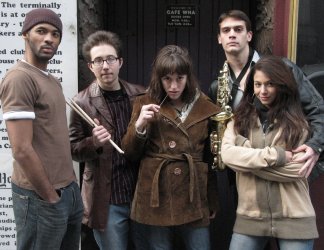Written by Sophia Romma Directed by Yuri Joffe
"Absolute Clarity" by Sophia Romma, directed by Yuri Joffe--a noted, Stanislavsky prize-winning director from Moscow's Mayakovsky Academic Theater--will be presented by ArtVoice and Cinema Anastasia as an Off-Broadway production at the Players Theater, 115 Macdougal Street, January 25 to February 25. The play is loosely based on "She, in the absence of love and death" by the noted Russian author Edvard Radzinski (1977). Radzinski's tragicomedy, originally set in a Soviet cityscape of the 1970s, has been re-imagined in the present-day Lower East Side, where its teenage heroine, a "white raven" and rebellious young artist, searches for love and absolution. The company of ten features a live onstage jazz band.
ABOUT "ABSOLUTE CLARITY"
The piece is a cinematic, tragicomic coming-of-age story. Its central character, Clare, is a lonely lover, an irreverent dreamer, a rebellious daughter, and the obsession of jazz musicians. She evokes a number of Dostoyevskian themes as she lives in a world of melodies and double meanings: love is still love, even if it's imagined; death is still death, even if it's an accident. Clare struggles to actualize herself as an artist, fights for independence against her mother, briefly joins a pickpocket-filled jazz band, and revisits the lawyer and judge of her childhood custody trial, triggering disastrous consequences. Her world is populated by women who, like herself, grasp for kernels of happiness, and by men that they love and betray, who also abuse them mercilessly.

Radzinski's original play investigated the universal theme of a complex and troubled soul falling in love. It was one part of a trilogy with the collective title "Love's Riddle," including also "Don Juan's Adventures Continue" and "Once Again on the Topic of Love." "She, in the absence of love and death" is set in a Communist world rife with single women but nearly lacking single men. The characters, each disillusioned with this sociopolitical situation, experience unique and delightful dreams, though their lives still seem disturbingly similar. The play is set in a 1970s communist cityscape in the Soviet Union, in which organized singles' parties dwelt side by side with the government. In the midst of this world is "She" (the character has no other name), a teenage girl who is a mouthpiece for the author. "She" speaks in the voice of a wise sage, in an extraordinary series of long monologues, all on the subject of love. The play's other characters, both men and women, converse endlessly about love. In a very quirky way, the play explores the difference between reality and imagination, desire and possibility.
Sophia Romma wrote her play in consultation with Radzinski, and with his approval, Romma transformed his play's teenage protagonist into a personal creation of her own. "She," renamed Clare, became what in Russian cultures would be called a "white raven"--an artistic nonconformist, like Treplev in Chekhov's "The Seagull." Her dialogue is written rhythmically, to be accompanied by a punk-jazz band filed with pickpockets that she briefly joins and which accompanies her scenes. Subplots were also introduced that "raise the stakes" for Clare's youthful odyssey. She fights doggedly for independence from her mother, a former porno star who is now a lounge dancer. While searching for her birth father, she finds the lawyer who lost his case for custody of her as a small child and seduces him, leading ultimately to a tragic ending. Clare also engages in stunning episodes that are only played out visually, as when she paints her own body inside a "confessional" as an ultimate act of adolescent defiance.
As Radzinski's Moscow apartment setting was transferred to a gathering of apartments on New York's Lower East Side, there was also a nearly complete shift in dramatic style. From a collection of spoken monologues, the play became a musically-accompanied, cinematically-styled collage. "Absolute Clarity" has no simple dramatic line, but a web of interconnections. There are no customary scenes; the action takes place separately and simultaneously in the various apartments. The characters share a common emotional line. If a question is raised, it is often answered in another part of the stage.
The idea for this play was born in Moscow in 2006, when noted Russian director Yuri Joffe observed Sophia Romma in her 2006 poetry book signing at the Gorky Literary Institute in Moscow. Joffe had previously directed Radzinski's "Conversations with Socrates" and "Nero and Seneca" and is planning an upcoming production of Radzinski's "To Kill a Man." Joffe saw similarities between Romma's poetry and the character of "She," who speaks of her own life in poetry, and imagined that as a promising concept for an English language play. Joffe also knew Romma's playwriting style well, having directed her play, "Shoot Them in the Cornfields," in New York in 2006.
Joffe had also directed "She, in the absence of love and death" in 2002 with his own interpretation, which set the play among the new generation of Muscovites and was very sinister in comparison to the original. From Joffe's perspective, the essential change from Radzinski's play to Romma's is the shift of the teenage protagonist from a philosophical obsession to a poetic incarnation. Since Clare is an artist, she accepts and sees the world in colors, art and poetry; this idea dictates the style of the play.
January 31 to February 25, 2007
Preview performances Jan. 31 & Feb. 1.
Opens 7:30 pm Feb. 2.
Players Theater, 115 Macdougal Street, Manhattan
Presented by ArtVoice and
Cinema Anastasia Productions
Wed-Sun at 7:30 PM,
Sat and Sun at 2:00 PM.
Tickets $45
